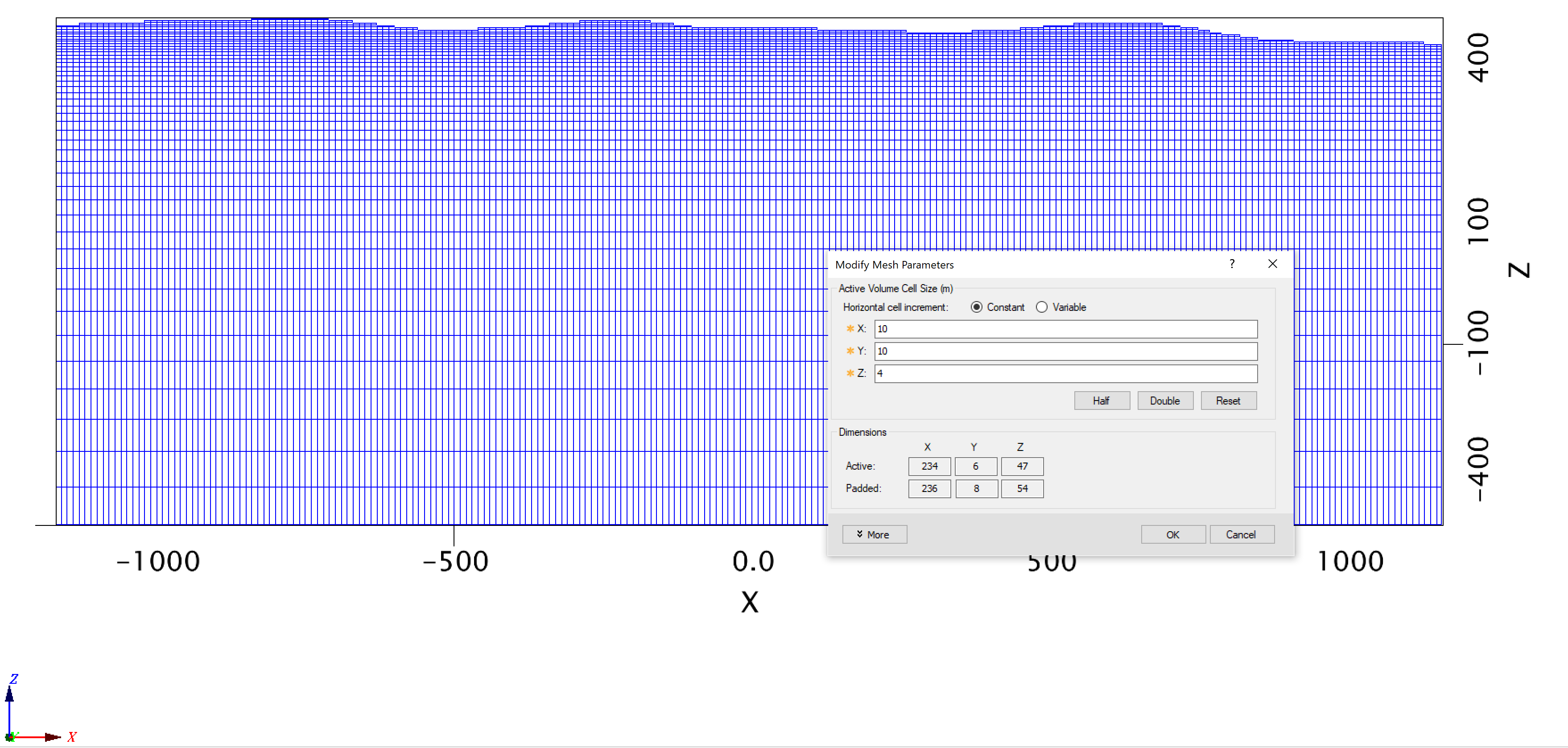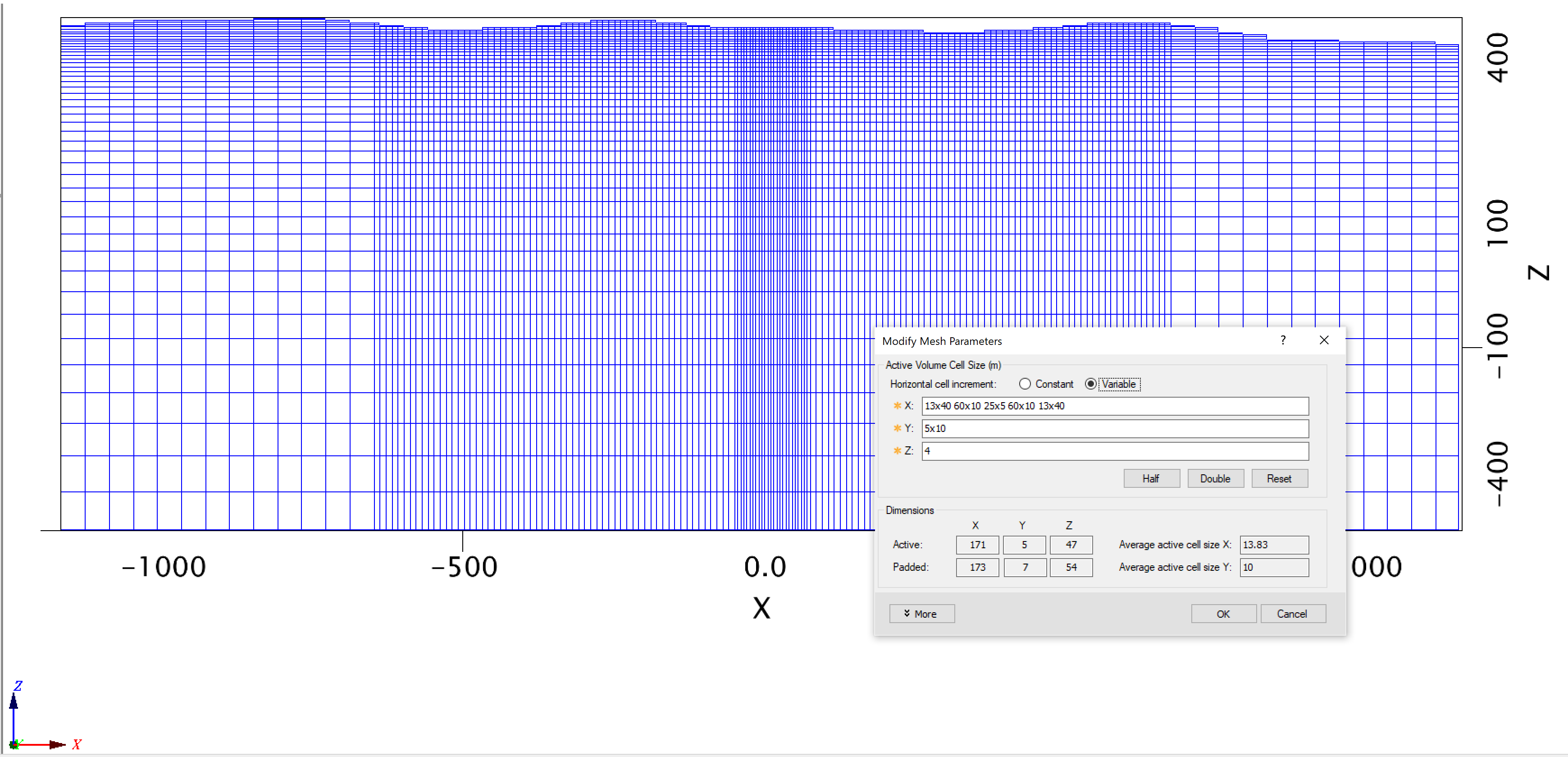Modify 1D TDEM Mesh Parameters
Use the Mesh > Modify option to change the default mesh generated by VOXI.
Modify Mesh Parameters dialog options
Active Volume Cell Size (m) |
||
|
Horizontal cell increment |
Horizontal mesh cells can have a constant or variable cell size. Variable horizontal cell increments are useful for creating areas of high or low resolution in the model based on data or constraint resolution, or desired model resolution. |
|
|
X,Y,Z |
The active volume cell size(s) along each axis. The syntax for defining variable cells is: n1xc1 n2xc2 n3xc3 etc… Where n is the number of cells and c is the cell size. |
|
|
[Half] |
Half the number or elements (double the resolution) along each major axis. |
|
|
[Double] |
Double the number of elements (half the resolution) along each major axis. |
|
|
[Reset] |
Restore the previously defined cell sizes. | |
Dimensions |
||
|
Active |
This read-only entry displays the number of cells along each axis of the area of interest. As the Active volume cell sizes are modified, these figures are recalculated to fully enclose the original mesh volume. The time and cost to perform an inversion is directly related to the dimension of the mesh. |
|
|
Padded |
The padded volumes are also displayed for your information. |
|
|
Average active cell size |
Displays the average of the X & Y cell sizes. These figures are only of interest if you have opted for the variable horizontal cell size option. | |
|
[More] |
Access advanced mesh settings. | |
|
[OK] |
Proceed to the next step. |
|
Expanded dialog options
|
Depth |
The next six entries pertain to the vertical axis. |
|
|
Top of model |
The maximum elevation of the terrain. |
|
|
Lin-log transition |
The value along the vertical axis at which to transition to a logarithmic cell expansion. |
|
|
Bottom of model |
The bottom of the voxel model along the vertical axis. |
|
|
Expansion ratio |
The vertical increment is constant for all cells above the lowest point of the terrain. Below that level, the cell size increases with depth by this factor. | |
|
Padding cells |
Number of padding cells to add to the bottom of the voxel model. Padding is required; see note below. |
|
|
Padding expansion ratio |
The intent of the padding cells is to minimize the edge effect in the predicted field. The padded cell size can be expanded when moving away from the active volume in order to cover a larger area. |
|
|
Horizontal Padding |
The next two entries pertain to the horizontal (x and y) axes. |
|
|
Cells |
Number of padding cells to add on either side of the x and y axes. Padding is required; see note below. |
|
|
Expansion ratio |
The padding cells can be expanded at different rates along the horizontal and vertical axes. |
|
|
Active Volume |
The active volume extents are updated to reflect the changes to the above parameters. |
|
Application Notes
By default, VOXI sets up the mesh according to the area of interest (AoI), the terrain relief, and the user selected horizontal cell size. The VOXI model mesh is a 3D voxel model that represents Earth as a collection of adjacent voxel cells. The mesh is referred to as the Active Volume.
The Active Volume hangs below the terrain and extends downward to approximately half the minimum dimension of the area of interest, but it should not exceed a reasonable exploration depth. In most cases, exploration becomes uneconomical below a couple of kilometres. Electrical methods generally have a lesser depth of penetration; thus, the default vertical extent of the mesh is set accordingly.
The Mesh Parameters can be refined to better suit the targeted model. Bear in mind that reducing the cell size increases the size of the mesh, the time required to perform the computation, and the cost of the inversion.
Changing mesh parameters will create a new mesh; all constraints in the model will be re-sampled to the new mesh.
Figure 1: Constant horizontal cell increment of 10 m

Figure 2: Variable horizontal cell increment

Access Seequent Online Learning and select the VOXI guided paths to learn more about effective workflows and key concepts.
See Also:
Got a question? Visit the Seequent forums or Seequent support
© 2023 Seequent, The Bentley Subsurface Company
Privacy | Terms of Use
